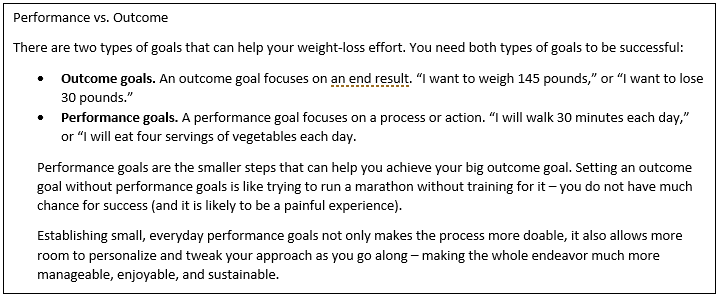Live your Healthiest Life series: Setting personal wellness goals and how they can help you be successful
Achieving and maintaining a healthy lifestyle is a lifelong journey, and there may be times when the task may seem overwhelming. Living your healthiest life is a big project – possibly one of your biggest undertakings yet.
As with any big project, if you focus only on the end result (which may seem endlessly far away!) the process may seem daunting. For those trying to lose weight, setting goals can often mean the difference between success and failure. Goals help motivate you and keep you focused. They put your thoughts into actions and help you meet your expectations. But goal setting is not as easy as it may seem. You cannot just write something down and expect that it will happen.
Your ability to reach your fitness and wellness goals is closely tied to how realistic they are. Many have unrealistic expectations. They set goals for themselves that are too big, too quick, too impractical. Before you identify your goals, take some time to reflect on your situation. You know you want to lose weight, but why? What is it that you are really striving for? Once you have answers (or at least some pretty good assumptions), develop a plan. Break those big goals down into smaller steps that seem within your grasp.
Here is a hands-on guide to help you establish and achieve your goals.
If you have not already, write down each of your goals on a piece of paper. Underneath write why this goal is important to you. What is it that is motivating you to make this big change in your lifestyle? Next, ask yourself how confident you are that you can achieve each of the goals you have written down. If you have more than one goal, consider whether working on multiple goals at once will be distracting or energizing. Analyzing your goals may cause you to refine or even change them. Perhaps your goal of losing 50 pounds was sparked by an upcoming class reunion, but now you realize what you really want is just to get healthier and feel better. Most often personal health goals tend to center around weight, activity, healthy eating and feeling better.

It is OK to dream big. Big things do not happen unless you have big aspirations. But recognize that big things typically do not happen without big efforts. Champion athletes do not become champions and then start training like one. It is the other way around – they dream big, do the necessary preparation, and then carry out their plan to reach their goals.
So, dream big if you want to – keeping realism in mind – but understand that you will need a well-planned effort to reach your healthiest life.
